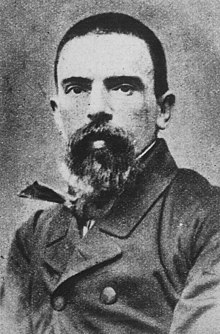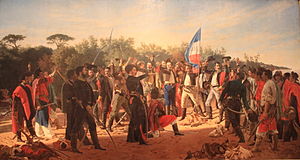Juan Manuel Blanes

You can helpexpand this article with text translated fromthe corresponding articlein Spanish.(March 2022)Click [show] for important translation instructions.
|
Juan Manuel Blanes(June 8, 1830 – April 15, 1901) was aUruguayanpainter of theRealistschool.
Life and work[edit]

Blanes was born inMontevideo,Uruguay,in 1830. He was raised by his mother, with whom he relocated to the countryside in his early teens. Blanes took an interest in drawing at this point, and shortly afterwards, was hired as an illustrator for a Montevideo news daily,El Defensor de la Independencia Americana.Earning extra income withwatercolors,he returned to his mother and, in 1854, established his firstatelier.[1]
He married María Linari, and in 1855, the couple settled inSalto,where he worked as a portrait painter. They relocated toConcepción del Uruguay(across theUruguay River,inArgentina) in 1857, and Blanes was commissioned by Argentine PresidentJusto José de Urquizato complete a number of portraits, allegories and landscapes to grace his nearbyestancia,thePalacio San José.Returning to Montevideo in 1861, the talented painter obtained a scholarship from the Uruguayan government, and with it, traveled with his family toFlorence,Italy,where he studied underAntonio Ciseriuntil 1864.
The experience became a valuable calling card for Blanes, who became one of Uruguay's most sought-after portraiteurs. The 1871 outbreak of ayellow feverepidemic inBuenos Airesinspired his first renowned work, which he exhibited to acclaim in the recovering city. His 1872 portrait of theArgentine War of Independencehero, GeneralJosé de San Martín(The Review inRancagua), was also a success in Buenos Aires, and Blanes was invited toChileto display the historic depiction.[1]
Works of Uruguayan national importance[edit]

Returning to Uruguay, Blanes undertook a portrait of the "Thirty-three Easterners",members of a revolutionary vanguard whose insurrection againstBrazilianauthorities resulted in Uruguayan Independence, in 1828. The portrait's 1877 display was followed by Blanes' second stay in Florence, where he completedThe Battle of Sarandí,a depiction of another milestone in Uruguay's nationhood. These works, and his bucolic portraits of life in his homeland did not garner the interest he expected in Italy, however, and the Blaneses returned to Montevideo in the early 1880s.[1]
Blanes resumed his portrait work, which remained popular among the local gentry. Among the most notable was a portrait of PresidentMáximo Santos,commissioned by friends of the ruler as a gift. The most well known from this later period, however, wasArtigas en la Ciudadela,an homage to one of Uruguay's most respected early patriots,José Gervasio Artigas.
Later life and legacy[edit]
This success was followed by the 1889 death of Blanes' wife, however, and he and his younger son, Nicanor, spent the next two years inRome,where his elder son, Juan Luis, had settled.
He returned to Uruguay alone, and continued to createhistoricandlandscape art.A few years later, Juan Luis lost his life in an accident and in 1899, Nicanor disappeared inPisa.Blanes hurried to the Tuscan city in hopes of locating his son, and a friend from a previous visit made him a guest in her house. Searching for nearly two years, the 70-year-old Blanes died in Ms. Manetti's Vía di Mezzo residence.[1]
The city of Montevideo established theMunicipal Museum of Fine Arts,and named it in his honor, in 1930; many of his best-known works are also displayed in the National Museum of Visual Arts. Washington D.C.'sGeneral José Gervasio Artigasstatue, based on Blanes' portrait, was cast in bronze in Uruguay duringWorld War IIas a gift to theUnited States.
-
The Pure Susanna
-
The Paraguayan Woman(1879)
-
Artigas in Ciudadela(1884)
References[edit]
- ^abcdMuseo Blanes: Biografía(in Spanish)Archived2009-02-10 at theWayback Machine



